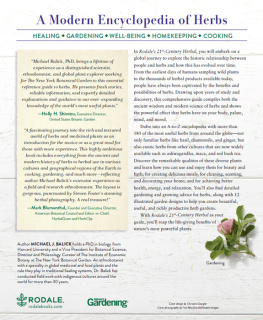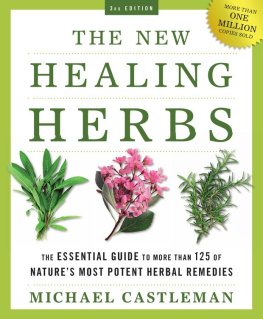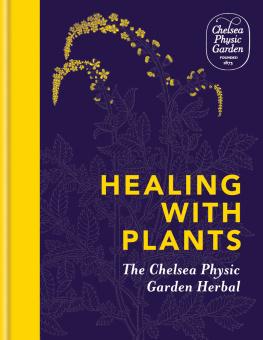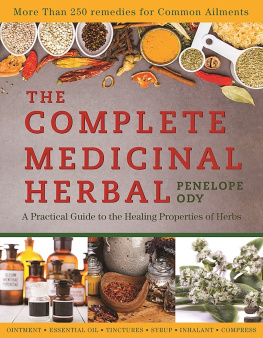PRAISE FOR THIS TITLE
Michael Balick, PhD, brings a lifetime of experience as a distinguished scientist, ethnobotanist, and global plant explorer working for The New York Botanical Garden to this essential reference guide to herbs. He presents fresh stories, reliable information, and expertly detailed explanations and guidance to our ever-expanding knowledge of the worlds most useful plants.
Holly H. Shimizu, Executive Director, United States Botanic Garden
A fascinating journey into the rich and textured world of herbs and medicinal plants as an introduction for the novice or as a great read for those with more experience. This highly ambitious book includes everything from the ancient and modern history of herbs to herbal use in various cultures and geographical regions of the Earth to cooking, gardening, and much morereflecting author Michael Balicks extensive experience as a field and research ethnobotanist. The layout is gorgeous, punctuated by Steven Fosters stunning herbal photography. A real treasure!
Mark Blumenthal, Founder and Executive Director, American Botanical Council and Editor-in-Chief, HerbalGram and HerbClip
About the Author
Author MICHAEL J. BALICK holds a PhD in biology from Harvard University and is Vice President for Botanical Science, Director and Philecology Curator of The Institute of Economic Botany at The New York Botanical Garden. An ethnobotanist with a specialty in global medicinal and food plants and the role they play in traditional healing systems, Dr. Balick has conducted field work with indigenous cultures around the world for more than 30 years.

Learn more about books that will inspire and
enable you to improve your life and the world around you.
Follow us @RodaleBooks



rodalebooks.com

This book is intended as a reference volume only, not as a medical manual. It does not purport to be, nor is it intended to be, a self-treatment guide for the use of herbs. In matters of your health care, we recommend that you consult a qualified health practitioner. The information given here is designed to help you make informed decisions about your health. It is not intended as a substitute for any treatment that may have been prescribed by your doctor. If you suspect that you have a medical problem, we urge you to seek competent medical help.
Mention of specific companies, organizations, or authorities in this book does not imply endorsement by the author or publisher, nor does mention of specific companies, organizations, or authorities imply that they endorse this book, its author, or the publisher.
Internet addresses and telephone numbers given in this book were accurate at the time it went to press.
2014 by Rodale Inc.
All rights reserved. No part of this publication may be reproduced or transmitted in any form or by any means, electronic or mechanical, including photocopying, recording, or any other information storage and retrieval system, without the written permission of the publisher.
Illustrations by Lizzie Harper, www.lizzieharper.co.uk
Photography Credits can be found on .
Book design by Christina Gaugler
Library of Congress Cataloging-in-Publication Data is on file with the publisher.
eISBN 9781609618056

We inspire and enable people to improve their lives and the world around them.
rodalebooks.com
In all that we do, it has been said that we stand on the shoulders of the giants who have come before us, building on their accomplishments. It is in that spirit that this book honors all of those people from so many different walks of life who have helped bring greater clarity to our understanding of the relationship between plants and people and the usefulness of herbs.

Contents
:
:
:
:
:
:
:
:
:
FOREWORD

Herbs have not only made me a better doctor, but they have also enriched my life in general. I am an avid gardener and home cook, and I enjoy growing and using culinary herbs, both familiar and exotic. Herbs are diverse and fascinating, as are the ways that people interact with them. Whenever I travel, Im always on the lookout for culturally specific uses of herbs that are new to me, and Im as likely to find them in developed societies as in more traditional ones.
Dr. Michael Balick loves plants as much as I do. He is one of our foremost ethnobotanical researchersthe best expert I can think of to introduce readers to the world of herbs. Mike and I both had the good fortune to be students of the late Dr. Richard Evans Schultes, director of the Harvard Botanical Museum and the godfather of modern ethnobotany. Dick Schultes inspired in us a passion for understanding the usefulness of plants and teaching their uses to others. I completed my undergraduate studies in ethnobotany under his direction and then attended Harvard Medical School, gaining botanical knowledge and experience that have served me very well in my medical career; they are a foundation of the integrative medicine that I practice and teach.
While still in medical school, I began to travel throughout the world to learn about the medicinal plants used by indigenous peoples. Later, I joined the research faculty of the Harvard Botanical Museum and continued to work with Dick Schultes. I became proficient in botanical medicine and soon was relying more on herbal remedies than on pharmaceutical drugs in my practice. Along the way, I also learned as much as I could about culinary and other uses of herbs.
I came to recognize profound differences between whole plants and chemicals isolated from them. The chemistry of plants is wonderfully complex, and the therapeutic actions of herbal remedies are shaped by that complexity, making them safer and often more effective than the highly purified compounds in pharmaceutical drugs. In many areas of contemporary science, theories and models based in complexity have proved very successful in describing and predicting diverse natural phenomenafrom weather to the behavior of social insects. Oddly, medicine has made little use of complexity theory, even though doctors deal with the most complex production of nature, the human organism. Integrative medicine is attempting to remedy that by developing research models to evaluate complex treatment protocols, for example, and also by teaching physicians how natural remedies interact with the body in ways different from isolated chemical compounds. Its an excitingand promisingnew approach.


















